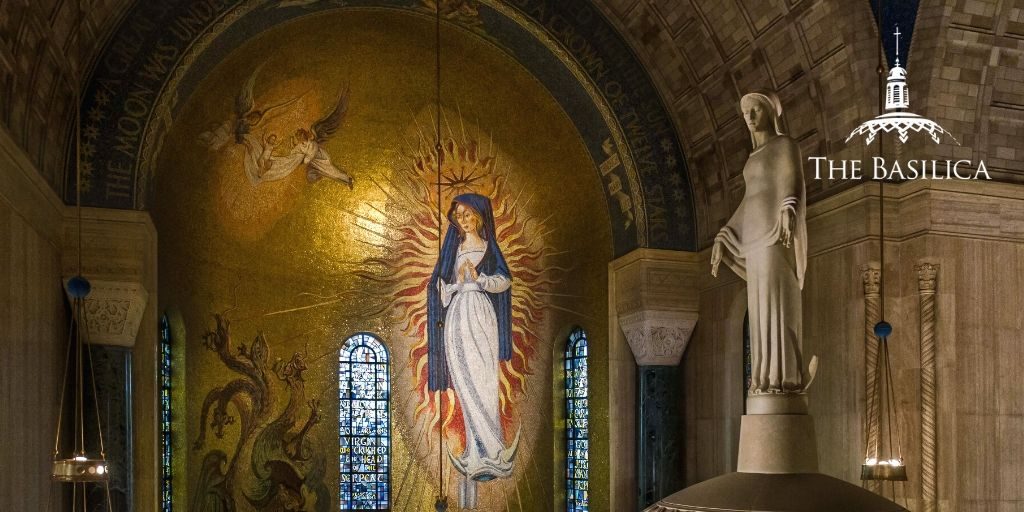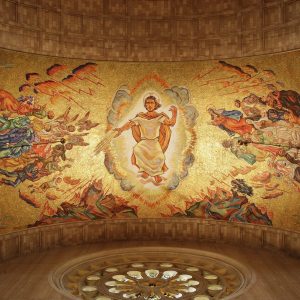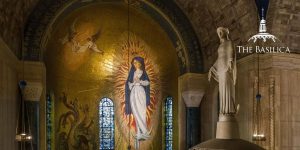
The Basilica is home to a massive collection of mosaic artistry, which is characteristic of its Byzantine-Romanesque style. Distributed throughout its five domes and more than 80 chapels and oratories, the interior mosaics of the Basilica total 93,845 square feet. In early Church history, art played an important role in showing churchgoers what they were unable to read for themselves. Today, the mosaics of the Basilica are still powerful visuals, bringing the truth of the Gospel to life in a tangible way. Here’s a look at just a few of the many mosaics that grace the walls and ceilings of the Great Upper Church.
 The Great Upper Church Domes
The Great Upper Church Domes
In the Great Upper Church, there are five distinctive domes: the Incarnation Dome, the Redemption Dome, the Trinity Dome, the Sanctification Dome, and the Glorification Dome. Together, they form a timeline of the New Testament.
The Incarnation Dome depicts the moment at which Christ came to earth as a man. The Redemption Dome shows the story of how Christ redeemed us through his death and resurrection. The Trinity Dome displays the Father, the Son seated at his right hand, and above them, the Holy Spirit in the form of a dove, along with Mary as the Immaculate Conception. The Sanctification Dome portrays the Descent of the Holy Spirit, when the apostles were empowered to go and preach the Gospel to the ends of the earth. The Glorification Dome depicts the prophecies of the end times and the Triumph of the Lamb. This dome naturally leads to Christ in Majesty, the mosaic of Christ in all his glory as he will appear at his return. Read more about the domes here.
 The Christ in Majesty Mosaic
The Christ in Majesty Mosaic
The Christ in Majesty mosaic, which dominates the North Apse of the Great Upper Church, is one of the largest mosaic images of Jesus Christ in the world, measuring 34 feet from hand to hand. Containing more than 4,000 shades and colors, the mosaic is inspired by Isaiah 63:1-2:
Who is this that comes from Edom,
in crimsoned garments, from Bozrah?
Who is this, glorious in his apparel,
striding in the greatness of his strength?
“It is I, I who announce vindication,
mighty to save.”
Why is your apparel red,
and your garments like one who treads the wine press?
On Dedication Day, November 20, 1959, Christ in Majesty was the only mosaic ornamentation in the Great Upper Church.
St. Joseph, Defender of the Church and Patron of Workers and The Woman Clothed with the Sun
In the East and West Apses, Mary and Joseph are depicted in The Woman Clothed with the Sun and St. Joseph, Defender of the Church and Patron of Workers mosaics. These two mosaics are each 3,570 square feet. The Woman Clothed with the Sun is inspired by Chapter 12 of Revelation.
 The Creation and Second Coming
The Creation and Second Coming
The East and West Transepts feature mosaics of the Creation and the Second Coming. The Creation displays the six days of creation, with Adam and Eve at the center, coming from God’s hand. Underneath them, an embryo symbolizes the generations that are to follow them. The Second Coming shows Christ in clouds of glory, reaching out to us on earth. He is flanked by the known saints on the right, and the unknown saints on the left, while distorted persons in blue and green represent those who have rejected Christ. These mosaics were the first that incorporated computer technology to determine the size and shape of the tiles that would fit in the transepts.
 The Immaculate Conception
The Immaculate Conception
The Immaculate Conception Mosaic at the Basilica is a gift of Popes Benedict XV and Pius XI and contains 250,000 pieces of natural stone in 35,000 different hues, sanded smooth to resemble a painting. Taking more than five years to create, it is based on a famous oil painting by the Spanish artist Bartolomé Esteban Murillo, La Purísima Bionda.


